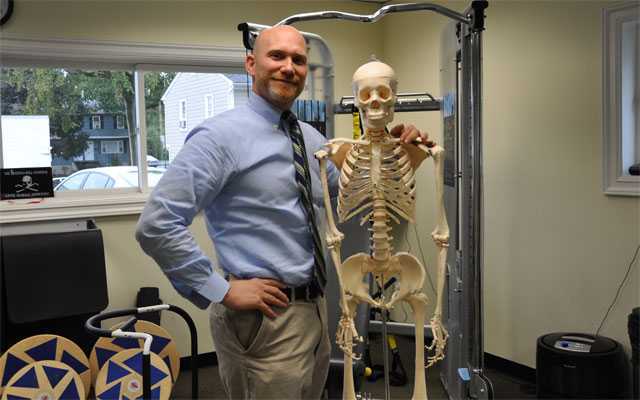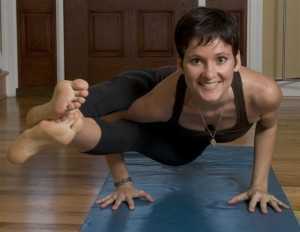While many prenatal women practice yoga to stay healthy and fit during pregnancy, prenatal yoga is becoming a more and more popular tool to prepare women for labor. The topic of prenatal pregnancy was recently covered in the Welland Tribune. The article, titled “Prenatal Yoga Gets Women Ready for Birth,” follows Angela Sacco, a registered nurse and pre- and post-natal fitness specialist. Sacco has attended more than 100 births. Her eight-week program is specially-tailored to aid pregnant women as they prepare for giving birth.
According to Sacco, “Yoga in the delivery room, be it home or hospital, is meant to relieve pain, build confidence and make it all go quicker.”
Although the fitness benefits – enhanced strength, stamina, and flexibility – are significant, Sacco’s program’s greatest asset may be that it allows participants to understand the natural processes of child-birth. Furthermore, with this understanding comes vital confidence, intangible equally central to a successful labor.

This September, H&W will be offering a course on Yoga for the Pregnant Patient. This course is designed to teach therapists on how to safely recommend yoga prescriptions through each stage of pregnancy.
This November, Herman & Wallace is proud to bring our Differential Diagnostics of Chronic Pelvic Pain and Dysfunction to Orlando, FL! This three-day course is taught by Peter Philip, PT, ScD, COMT.

Pelvic Rehab Report sat down with Peter recently to talk to him about his course.
What can you tell us about this continuing education course that is not mentioned in the “course description” and “objectives” that are posted online?
There are many cause of pelvic pain! For instance, the pudendal nerve is often implicated as the sole source of pelvic pain, and this is simply not true. This course covers multiple reasons and nerves that can cause pelvic pain and dysfunction, and instructs participants on how to determine the exact tissue at fault when approaching patients with pelvic pain and dysfunction.
The course also covers the multiple factors and etiologies leading to the formation of muscle spasms, so that muscle spasms can be treated and, ultimately, eliminated.
At the course, the clinician will learn to determine the origin along the neuroaxis where his/her patient’s pain initiates, and - more importantly - how to specifically address and remedy the patient’s ailments.
The lecture portion of the course is based on applied anatomy and differential tissue tension. Lab sessions cover palpation strategies. After the course, there will be no more ‘guessing’ which and what structure is being palpated; the clinician will know.
The clinician will learn how to palpate, test and treat the anterior sacroiliac joint ligament, and learn its role in not only pelvic pain, but lower back pain as well.
The course also covers how to specifically test each sacral nerve, and to determine its contribution to the patient’s pain and dysfunction.
Using these techniques, I expect to have a positive impact on my patient population within three visits. The goal of my course is to teach other clinicians to do this for their patients too.
What inspired you to create this course?
My first patient with pelvic pain took his own life as a result of his persistent pain, and the secondary losses of career and relationships. This had a huge impact on me, and was coupled with a frustration that I felt because there wasn’t a means of accurately determining the exact tissue at fault in the initiation and perpetuation of a patient’s pain and dysfunction.
What resources and research were used when writing this course?
Over fifteen years of research and clinical experience went in to the development and formation of the content and information presented in this course. I drew from the orthopedic, neurophysiologic, urogynecologic and pathophysiologic practices and research and integrating these practices into a unified, progressive evaluation and treatment strategy.
Can you describe the clinical/treatment approach/techniques covered in this continuing education course?
The general concept is that every pain has a source. It is up to the clinician to determine what that cause is, and to formulate a treatment strategy that reflects and accurately addresses the tissue(s) at fault. In doing so, both the clinician and the patient will notice immediate resolution of pain, spasm and dysfunction.
Why should a therapist take this course? How can these skill sets benefit his/ her practice?
This course provides all clinicians with the opportunity to understand the entirety and complexity of the patient with pelvic pain, and dysfunction. The clinician will understand the role and interaction of the brain, spinal cord, spinal joints, sacroiliac joint, hip joints, ligaments of the spine and sacroiliac joint, and individual nerve roots have in the initiation and perpetuation of their pain and dysfunction.
This course is a must for clinicians who are eager to learn more about chronic pelvic pain and dysfunction. Seats are limited so register today!
Although exercise is critical for pregnant women (just as it is for everyone), few receive the appropriate amount of exercise. This may seem intuitive, but physical symptoms of pregnancy often are a barrier to physical activity for women.
A recent Research Report article published in The Journal of Women's Health - Physical Therapy, titled “The Impact of Symptom Type and Frequency on Activity Level During Pregnancy,” studying the daily records of physical activity for “sedentary women with a history of preeclampsia,” discusses how maternal weight and gestational age affect activity levels. For example, women who are already over-weight have lower activity levels during pregnancy. Similarly, the further along the baby is, the less likely the mother is to be physically active. Women, after week 28, have the greatest reduction in physical activity.
This is problematic because a healthy mom is crucial for both the health of the mother and the health of the baby. Furthermore, symptoms like fatigue and backache decrease among more active moms. Gestational diabetes and cardiovascular disease are less likely among active moms as well. Over-exercise can be detrimental as well; however, the numbers of women over-exercising during pregnancy is negligible compared to the majority, who are under-active during pregnancy. Often, these physiological problems persist after pregnancy.
Therefore, the challenge for therapists is to find a way to educate their pregnant patients about the importance of physical activity during pregnancy as well as give them advice on how to implement an active lifestyle within their daily routine. H&W recently expanded our courses on pregnant, peripartum, and postpartum patient care to help therapists when they treat these patients. Check out the following events on the horizon in the coming months:
Care of the Pregnant Patient
Winter Park, FL. Sept. 21-22, 2013
Despite the fact that millions of men and women experience pelvic floor dysfunction, it is often and incorrectly considered a “women’s health issue” and pelvic rehabilitation is often thought to be the province of Women’s Health physical therapists. Information about pelvic rehabilitation is often couched in language that revolves around perinatal and elderly female patients, while ignoring men, athletes, and teens.
For example, both male and female athletes can be frequent sufferers of pelvic floor dysfunction, as a by-product of the extreme stress high level performance takes on their bodies, often linked to sports hernia and femoroacetabular impingement.
This year, Herman & Wallace is introducing a new course which applies a sports medicine approach to treating the pelvic floor and core. Biomechanics of the Hip and Pelvis illustrates how understanding pelvic balance and manual movement therapy are integral to treating and preventing injury. This course is instructed by Steve Dischiavi, MPT, DPT, ATC, COMT, CSCS, who is the PT for the Florida Panthers hockey team and is applicable to treating all patients: from men to new moms, athletes to the elderly.
H&W faculty instructor, Stacey Futterman, PT, MPT, WCS, BCB-PMD, had this to say about Steve:
“I have known Steve for years and have tremendous respected for his orthopedic and sports medicine skills. After I took Steve’s course on how to implement the integrated sling systems, I developed therapeutic exercise programs for my clients that were more core and hip focused. I was amazed when I leaned how I could use the same theories Steve applies with his professional athletes to my pelvic and women’s health clients of all ages. It’s also a great course to understand body mechanics as it pertains to the hip and pelvis when applying it to exercise. Clinicians of all disciplines from sports medicine to women's health will enjoy Steve's a dynamic speaking style and wide knowledge base.”
Fellow H&W faculty instructor Pamela A. Downey, PT, DPT, WCS, BCB-PMD, said:
“Steve is an accomplished PT, works with high level athletes (the hockey team here the Panthers) and teaches in the t-DPT at NSU, where I have met him. He really understands the hip and trunk stabilization and is a manual therapist. He was a very effective speaker, with good labs, excellent slides and media pieces, and genuinely likes to teach.”
H&W is thrilled to be launching this brand new course in 2013. Don’t miss your chance to expand your skill set and approach – register today!
Pudendal Neuralgia (PN) is a neuropathic condition that causes patients to suffer chronic pain or numbness. Furthermore, PN is often accompanied by fecal incontinence, urinary incontinence, and numbness of the genitalia. Patients experiencing PN struggle with one of the most difficult nerve conditions and one that affects men and women alike.
Physical therapy has shown itself to be one of the few methods to successfully treat PN. However, few physical therapists have the knowledge, experience, and skills required. Recently, Greg Vigna, M.D., J.D. wrote an article for New York Injury News about pudendal neuralgia. In it, he describes the obstacles facing patients with PN:
"Historically the management of pudendal neuralgia was only available at a select few centers throughout the country. The reasons for this is that pudendal neuralgia was quite rare, often overlooked, and under diagnosed by the medical community. There are only a few doctors in this country who have received the advanced training in the management of this disorder. Even fewer have the advanced surgical training. A great number of physicians do not have a base understanding of the pudendal nerve and are unaware of pudendal neuralgia."
One of the reasons PN is so hard to diagnose, is that the most obvious symptom is intense pain while sitting. Patients associate the feeling with having a foreign body in your rectum or vagina. Men often feel pain while ejaculating or develop erectile dysfunction because of PN.
While women are twice as likely to suffer from PN as men, the condition affects people from all walks of life. PN was termed “cyclists syndrome” by French cyclists. Prolonged driving and sitting are also common causes. Young people who participate in sports, such as cyclists, runners, gymnasts, and horseback riders, also can be affected.
For women, PN frequently occurs immediately after childbirth. Sometimes, the symptoms are temporary. For others, the condition is not. Patients with PN notice symptoms of the condition throughout the day. As a patient’s day progresses, pain generally smarts as a patients activity level rises. These symptoms are often debilitating.
In August, Herman & Wallace will be offering a course on treating and assessing PN. Focusing on the pudendal nerve and pelvis, the course is designed to give medical practitioners the skills they need to rehabilitate those suffering from PN.
The course will be taught by Tracy Sher, MPT, CSCS and Loretta J. Robinson, PT, MS. Tracy is an accomplished pelvic and orthopedic physical therapist, who has presented for the International Pelvic Pain Society and the APTA’s Annual Conference. Loretta co-authored a paper on PN with Dr. Michael Hibner and has long been regarded as a leader in the field. Her practice exclusively serves men and women suffering pelvic dysfunction.
 Maureen Brennan, PT, PRPC graduated from the University of Illinois at Champaign with her Bachelor of Science degree in Kinesiology, 2001 and then completed her degree in Physical Therapy from the Chicago campus in 2003. She achieved her Pelvic Rehabilitation Practitioner Certification in 2014.
Maureen Brennan, PT, PRPC graduated from the University of Illinois at Champaign with her Bachelor of Science degree in Kinesiology, 2001 and then completed her degree in Physical Therapy from the Chicago campus in 2003. She achieved her Pelvic Rehabilitation Practitioner Certification in 2014.
Maureen has enjoyed treating patients at Rush University Medical Center for over a decade where she established a Women’s Health program and then expanded it to also include men and children. She is delighted to be part of the hospital’s Program for Abdominal and Pelvic Health which is a true multidisciplinary team that meets monthly to collaborate about challenging cases and offer continuing education opportunities for other health care professionals with an emphasis on the importance of teamwork.
In addition, she enjoys instructing a number of educational classes at the medical center that include prenatal education and pelvic floor health for employees and community members. She also presents talks focusing on a physical therapist’s perspective of pelvic floor dysfunction to Rush residents and physicians of neighboring hospitals.
In the clinic, she focuses on patient education and empowerment. She has real-time ultrasound and biofeedback machines available to support patient education. She is also certified in functional dry needling which has shown to be an invaluable modality to use with many of her patients in addition to her other manual skills such as visceral mobilization.
In our weekly feature section, Pelvic Rehab Report is proud to present this interview with newly certified practitioner Michele Syska, PT, PRPC
Describe Your Clinic:
Orthopedic manual based. I love figuring out how mechanical issues may be affecting the current presentation. I would also characterize my practice as open. I’m up for trying new ideas either from course work, other therapists or patients. I enjoy learning from the experience of others and have an open mind to many techniques.
What/who inspired you to become involved in pelvic rehabilitation?
I spoke with the therapist who had started the program at my clinic. She helped to bring knowledge and understanding to the world of pelvic floor dysfunction. She helped me gain motivation to attend my first course. Upon attending Herman and Wallace level 1, I can truly say that it was Holly and Kathe’s unique and passionate teaching that solidified my decision.
What population do you find most rewarding in treating and why?
Male chronic pelvic pain. For the most part, women are used to the medical profession “messing” with them. After having several paps and babies, most women don’t arrive with the embarrassment and anxiety that more often is associated with male pelvic pain. It’s rewarding to be able to bring comfort and relief to these patients through education and understanding. The progression from start to finish is typically more dramatic in the way they improve their overall comfort in talking about the dysfunction and the re-integration into their work and social lives.
What Role do you See Pelvic Rehab Playing in Overall Patient Health?
One’s ability to be continent, have normal sexual function and go through their day without pain, play a large role in general well-being. Looking for a restroom at every turn does not make for a very pleasant day. An unhealthy pelvic floor can be extremely debilitating. It can get in the way of basic daily activities and significantly affect ones social and work life.
Learn more about Michelle Syska, PT, PRPC at her Certified Pelvic Rehabilitation Practitioner bio page. You can also read more about the Pelvic Rehabilitation Practitioner Certification at www.hermanwallace.com/certification.
This October, Herman & Wallace is excited to bring a new course, Rehabilitation for Breast Cancer Patients, to White Plains, NY! This course will be taught by Susannah Haarmann, PT, CLT, WCS and Christine Cabelka, MPT, CLT, WCS.


Pelvic Rehab Report sat down with Susannah and Christine to ask them a bit about the course.
What can you tell us about this continuing education course that is not mentioned in the course description and objectives that are posted on-line?
Susannah: I would say that even though this course is entitled, “Rehabilitation for the Breast Cancer Patient,” much of the knowledge and skills learned in this course will transfer to other oncology populations. For example, we address fatigue, neuropathy, cardiomyopathy and osteoporosis, which are side effects many oncology patients report. I believe the demand for rehabilitation oncology programs will rise in the future. Clinicians attending this course have so much to bring to the table in terms of their current knowledge and skill-sets. It is my hope that blending the information and treatment approaches in this course with other specialty knowledge will bring about great inspiration and a whole host of creative treatment ideas!
Christine: We’re so excited to be teaching this course. We’re hoping to take the participants on the journey that the patients go through. Throughout the course the participant will be provided with multiple examples of what they may see in the clinic so they can begin building that image of a patient in their heads. They’ll be provided with the insight and reflection from real patients regarding their journey through breast cancer diagnosis, treatment, and recovery.
What inspired you to create this course?
C: Working with cancer patients inspired me to co-create this course. Seeing the lack of comfort from my colleagues working with the cancer population I wanted to create something that would provide any practitioner the knowledge and confidence to work with cancer patients, even if they don’t have training in lymphedema management. Not all patients will have access to therapists with advanced training in the oncology population, so being able to provide a high-quality course designed to train more practitioners will hopefully provide patients with better access to care.
S: When breast cancer patients and health care practitioners become aware of the potential of oncologic rehabilitation and the positive impact we can make, the current lack of services in this area is often seen as a travesty. Skilled rehabilitation providers are rare, and in-depth education addressing medical intervention and lab-based treatment approaches is difficult to find. As a result, many preventable side effects are not being addressed, referrals are not being made, and many patients are missing out on receiving these beneficial services.
My initial inspiration for creating this course came while working as a resident at Duke University and Medical Center. As a therapist at an educational institution, we received referrals from states away. Many times our patients were commuting hours to consult our rehab services or living locally on a short-term basis for treatment. Our team would make every attempt to find therapists in the patient’s area who were skilled in oncologic care and lymphedema treatment, but often times our searches were futile. In addition to being a rare commodity, often times I found confusion among therapists regarding medical interventions or standardized treatment approaches. I was inspired to create the course in order to ‘connect-the-dots’ for rehab professionals passionate about oncology care.
However, I feel my greatest inspiration for creating this course will come while teaching it; I can make a splash by treating one patient at a time, but educating practitioners who can then go out into the world and treat, we can really make waves!
What resources and research were used when writing this course?
S: Oh my goodness, the time performing literature reviews and collaborating with expert health care practitioners in the area of breast oncology was immense! With that said, I still feel like we only scratched the surface and I am very dedicated to the evolution of this course as new findings and materials are born! Specifically, the American Cancer Society’s journal ‘Cancer’ published a special issue entitled, “A Prospective Surveillance Model for Rehabilitation for Women with Breast Cancer;” the article reviews and expert opinions in these synopses were a great starting point. As a certified lymphedema therapist through the Norton School of Lymphedema, I definitely found myself delving into former course materials. Some of the best leads and most rewarding learning opportunities, however, came from collaborating with other practitioners within the field, such as nurse practitioners in plastic surgery, breast cancer nurse navigators, nutritionists, Pilate’s instructors, etc. Rehabilitation for the breast cancer patient truly is an integrative approach and we have a lot to learn from each other!
C: Numerous research articles were reviewed and cited. Issues and supplements of the Cancer journal are presented. We also were able to gain permission to use material from public cancer sources such as the American Cancer Society, National Institute of Health, National Lymphedema Network, and Chemocare.com.
Can you describe clinical/treatment approach/techniques covered in this continuing education course?
C: We’ll be covering a mix of everything from evaluation to treatment techniques. Based on the side effect of treatment being discussed we’ll be providing and/or reviewing techniques for evaluation of sensation, balance, and screening for lymphedema. We’ll also be providing instruction on manual techniques for treatment of axillary webbing. Specific intervention ideas for each treatment side effect will be covered.
S: Treatment techniques for this course run the gamut from exercise prescription for core strengthening status post breast cancer reconstruction to hands-on manual therapy for lymphatic cording. Although treatment approaches are impairment-based, this course supports the Prospective Surveillance Model which aims at preventative styles of treatment as well.
Why should a therapist take this course? How can these skill sets benefit his/her practice?
S: I have many answers to this question, but I will choose my top 3:
1. YOUR SERVICES ARE NEEDED!
A therapist should take this course because breast cancer is the most commonly diagnosed cancer among women, rehabilitation for the oncology patient is underutilized, and I guarantee there are cancer patients in your area that would greatly benefit from your services.
2. CHANGE LIVES!
I think that many therapists shy away from working with the oncology population because it may be considered depressing. However, the work can be incredibly rewarding and that is why this is one of my favorite populations! It is so evident to me on a daily basis how much my abilities as a therapist impact my breast cancer patients’ lives and often in a very short period of time. Frequently my oncology patients say therapy is their favorite form of treatment and that makes me smile!
3. GENERATE REFERRAL SOURCES!!!
A therapist who successfully completes this course, and makes a good relationship with an oncologist in their area, may create the potential for a greater number of referral sources to their clinic, thereby adding value and demand to their practice.
C: Therapists should take this course to build on their existing skills and give themselves the confidence to work with this patient population. We’re hoping to provide the tools needed for a therapist to recognize the need for early lymphedema intervention. Also to provide the skills to be able to work with breast cancer patients at any stage, from early on in the diagnosis, to 5 years into their survivorship.
This course is a must for clinicians who are eager to learn more about breast cancer rehab. Seats are limited – register today!
We are excited to announce Herman & Wallace instructor Ginger Garner, PT, MPT, ATC, PYT will speak at the National Athletic Trainers’ Association’s (NATA) 64th Annual Meeting and Clinical Symposia this June. Her advanced presentation, titled Yoga Pulls Double Duty: Establishing Controlled Flexibility in Athletes, has already sold out!

According to Ginger, yoga has been used as a theoretical healing system for more than five-thousand years. In 2001, she founded Professional Yoga Therapy Studies, an organization that blends yoga, sports medicine, and physical therapy curricula to educate clinicians and patients alike. Her medical yoga undergraduate, graduate, post-graduate, and medical continuing education programs are the first of their kind in the US. While her clinical focus ranges from orthopaedics to public health education, Ginger considers maternal health her most important work.
With PF1 Durham just around the corner, and PF1 Seattle in January sold-out with a 20-person wait list, our next PF1 is filling up quickly.
PF1 in Maywood, IL from March 1-3 is over half-full, and additional registrations are rolling in each day. If you are interested in joining us for PF1 in Maywood, do not hesitate to register. We expect this course to fill up before the holidays are upon us, so act quickly.
Once PF1 in Maywood is full, the next available PF1 is in Houston, TX in early May 2013. If you'd like to take this popular course before May of 2013, we suggest registering for the Maywood course today!
Stay tuned this week for a big announcement that we have coming up. We are adding a new highly requested feature to our website, which we are confident women's health physical therapists will find very helpful!














































